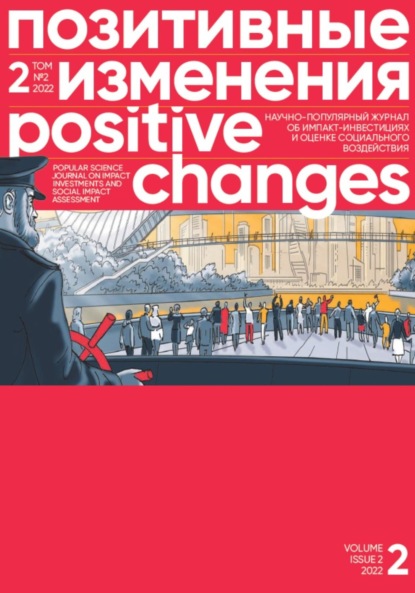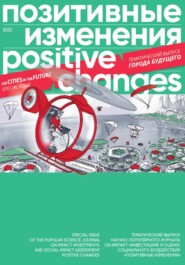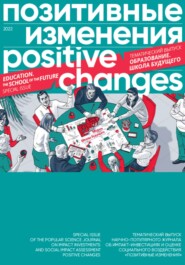По всем вопросам обращайтесь на: info@litportal.ru
(©) 2003-2024.
✖
Позитивные изменения. Том 2, № 2 (2022). Positive changes. Volume 2, Issue 2 (2022)
Настройки чтения
Размер шрифта
Высота строк
Поля
https://clck.ru/iYyQ2
СООБРАЖЕНИЯ ПО ОЦЕНКЕ ВОЗДЕЙСТВИЯ ДЛЯ ИНВЕСТОРОВ ЧАСТНОГО РЫНКА
2022, Журнал управления благосостоянием. Кеннет Б. Триппе и Эссма Бенгабсия
За последние два десятилетия на частных рынках значительно выросли активы, связанные с инвестициями в устойчивое развитие и социальное воздействие, причем с 2000 по 2020 год объем частных инвестиций, направленных на достижение экологических или социальных результатов, увеличился более чем в 20 раз (Pitchbook, 2021). Тем не менее, слабым местом для инвесторов и владельцев активов остается измерение и управление воздействием. В данной статье авторы анализируют существующие подходы к оценке воздействия и представляют методику расчета и агрегирования показателей воздействия по частному портфелю. Эта методология, созданная на основе ведущих систем измерения воздействия и с учетом мнений экспертов-консультантов, предоставляет инвесторам и владельцам активов руководство по сбору, агрегированию и отчетности по показателям воздействия по всему портфелю.
https://clck.ru/iZyMr
Impact Investing as an Object of Research. 2022 Publications Digest
A number of publications appeared by mid-2022, dedicated in one way or another to the issue of impact investing. Numerous articles, literature reviews and case studies attempt to identify the current status of the social investing sector and review the past experience – in other words, trying to figure out "where we are".
Elizaveta Zakharova
PhD student at the HSE Faculty of Social Sciences
Researchers are recording a rapid expansion of the social investment market, and although it is still notably small, there are many new contexts and problem areas waiting to be explored. Publications highlight the emerging phenomenon of impact washing, engagement of impact investing into women’s philanthropy and gender issues, and papers appear describing studies of local markets as well as studies of government intervention and political initiatives.
These and other topics are covered in our regular digest of impact investing publications for the first half of 2022.
NEW TRENDS IN WOMEN'S PHILANTHROPY
2022, Generosity and Gender. Palgrave Macmillan, Lois A. Buntz
As fundraisers and organizations across the globe continue to work in the field of women’s philanthropic initiatives, new trends, innovations and exciting connections happen every day. Some of these are emerging in existing nonprofits, others are collaborations with for-profit partners, HNW philanthropists and women’s foundations. Several areas of emerging trends will be explored in this chapter, including Impact and Gender Lens investing, LLCs as alternatives to family foundations, and the Maverick Collective, Emerson Collective, Blue Meridian and the Audacious Project.
https://clck.ru/iZYjo
THE IMPACT OF SOCIAL INVESTING ON CHARITABLE DONATIONS
2022, Management Science. lake An, Donnel Briley, Shai Danziger, Shai Levi
We examine the impact of social investing on charitable donations using a unique data set consisting of investment behaviors and donation transactions for more than 10,000 customers of an investment app platform. We find that investors switching to a recently introduced social fund reduced their donations, mainly in charities supporting causes similar to those of the social fund. However, 79 % of the investors that switched to the social fund did not donate before switching, so the social fund attracted more people to fund social causes. Still, because of the substitution effect, we estimate social funds have a positive effect on society only if their annual contributions to social causes are greater than 3.2 % of the balance invested.
https://clck.ru/iZ94m
IMPACT INVESTING AND NEW SOCIAL FUNDING, CHAPTER IN THE BOOK "ORGANIZING FOR SUSTAINABLE DEVELOPMENT: ADDRESSING THE GRAND CHALLENGES"
2022, Routledge. Federica Angeli, Ashley Metz, Jorg Raab
This chapter introduces readers to the idea of impact investing and how its definition has evolved in the literature. It also introduces the organizational actors involved and the instruments they use. Asset owners, such as retail investors, private foundations or sovereign wealth funds, hold the capital and decide about its allocation along the impact capital chain, thus deciding the impact orientation of the capital. All the actors belong to an ecosystem, where each member plays a critical role in trying to mitigate the risk of impact investments and expand the pipeline of investable opportunities. The analysis of the business model is, thus, a driving factor in understanding the organizational actors targeted by impact investing capital providers and in differentiating them in respect to those targeted by other types of social finance. The chapter concludes with a discussion of delivering on the promise of impact investing.
https://clck.ru/iYiM8
SOCIAL INVESTMENT PROJECTS: REGION-SPECIFIC RISKS
2022, Creative Economy. T. V. Bart, V. H. Martyniuk
In this article, the researchers review various actions stimulating investment in the social sphere, given the need to fight the consequences of the COVID-19 crisis and to maintain fiscal balance of the constituent entities of the Russian Federation. Regional development is analyzed by the tax potential index. The study highlights the advantage of the "Territory of Advanced Social and Economic Development" legal regime and the "Far Eastern concession" model to stimulate investment in social infrastructure projects. The authors reason that new instruments of debt financing – ESG-bonds, municipal and infrastructure bonds, crowdfunding, preferential budget lending – contribute to the growth of social investment projects, taking into account the assessment of regional sectoral risks, regulation and stimulating fiscal policy.
https://clck.ru/ia7jv
EVALUATION IN IMPACT INVESTING: WHERE WE ARE AND WHERE WE ARE GOING, CHAPTER IN THE BOOK "HANDBOOK OF RESEARCH ON GLOBAL ASPECTS OF SUSTAINABLE FINANCE IN TIMES OF CRISES" 2022, IGI Global
Eugenia Strano, Alessandro Rizzello and Annarita Trotta
The emergence of impact investing over the past decade has been accompanied by an increased interest of practitioners and scholars in the impact evaluation topic, one of the twofold pillars of the such an innovative financial approach. To contribute to the international debate, this study adopts a qualitative approach by obtaining results from a systematic literature review of extant research. This is useful to 1) identify the current existing impact evaluation approaches adopted in the field and 2) derive an empirical analysis in the impact investing sector with a focus on impact measurement in social impact bonds. The study opens interesting insights into recognizing the potential for the whole impact investing field, deriving both from theory and evidence of impact evaluation practices.
https://clck.ru/iYh5v
INFLUENCE OF MODERN "BUSINESS SOCIALIZATION" CONCEPTS ON COMPANIES' STRATEGIES
2022, Chelyabinsk State University Newsletter. E. V. Kozlova
More and more companies today take into account the environmental and social impact of their operations, while developing their strategies. Tightening environmental and social development requirements force companies to consider these in their development strategies and programs. Contemporary approaches to evaluating the effectiveness of sustainability projects tend to focus on measuring quantitative indicators (the number of activities carried out or the amounts invested), rather than on qualitative indicators (assessing the effectiveness of their impact on the environment). Despite widespread implementation of the sustainable development principles, there is still no unified evaluation methodology that would allow companies to measure their effectiveness and conduct comparative analysis within the country, industry or between individual enterprises. Increased public and stakeholder attention to corporate social responsibility results in the spread of negative phenomena such as impact washing.
https://clck.ru/iZt2P
BEHAVIOR CHANGE IN IMPACT INVESTING
2022, University of Michigan. Laura Dyer, Max Berry, Nathan Lohrmann, Max Odena
Climate change poses an existential threat to humanity, but funding to mitigate and adapt to a changing climate is not commensurate with the scale of the problem at hand. Across asset classes, there is insufficient funding for climate change mitigation and adaptation solutions. At the same time, however, over 140 billion dollars in private wealth is sitting idle, waiting to be deployed by its owners into philanthropic initiatives, charities, and income-generating investments, for example. There is a higher use for these funds, namely helping humankind mitigate and adapt to climate change. CapShift, our project partner, is a platform that empowers philanthropic and financial institutions, along with their clients, to mobilize capital for social and environmental change. It was founded with the idea that there needed to be a better way to give away and invest large sums of money in ways that benefit society and the environment. In 2020, they focused their energies on developing a racial justice framework to facilitate funding of racial justice-related opportunities. In 2021, their focus is on funding climate change mitigation and adaptation opportunities. In 2022, their focus is on funding agrifood solutions. Our team’s focus was on these 2021 and 2022 goals. CapShift found it’s hard to give away billions of dollars, let alone find uses for that money that will generate financial returns. While the latter makes intuitive sense for laypeople who might dabble in the stock market or retirement accounts, the former may sound nonsensical on its face; there should be plenty of people and organizations willing to accept money, the thinking goes. However, upon closer inspection, we see that it can, in fact, be challenging for high-net-worth individuals (HNWIs) and their fiduciaries, pensions, and other private wealth holders (together – "CapShift clients") to ensure their money will have the impact they want once it is given away, if they can find a worthy opportunity to which they can give their assets. Goals must be set and outputs, outcomes, and impacts of that money must be measured, reported, verified, and communicated. "Giving away" money for impact is sometimes as complicated as investing it for financial gain. Climate change mitigation, adaptation, and agrifood solutions represent an opportunity for CapShift clients to allocate their capital. Unfortunately, however, funding these opportunities are not presented to current and prospective CapShift clients in a way that inspires and mobilizes them to invest. We aim to change that.
https://clck.ru/iYpMG
THEORETICAL ASPECTS OF IMPACT INVESTING IN THE MODERN WORLD
2022, Science and Youth: Current Issues of Modern Scientific Research. E. S. Melnik
The article considers the definition of impact investing and analyzes its criteria. The author examines the benefits of impact investing, its impact on the society, and ways to accelerate the development of impact investing in Russia.
https://clck.ru/iZmsu
ESG INVESTING: GLOBAL AND RUSSIAN EXPERIENCE
2022, Economic and Social Problems of Russia. I. A. Chuvychkina
The article discusses the concept of responsible investing, its historical context and evolution. Particular attention is paid to the risks of responsible investing associated with the lack of reporting standards, ratings manipulation, and greenwashing. The author also touches upon the aspects of the climate change policy of the world’s major economies, the development of financial instruments and mechanisms necessary for «green» investment. An analysis of the Russian culture of responsible investing and the barriers to its implementation is conducted.
https://clck.ru/iZqyr
BETWEEN IMPACT AND RETURNS: PRIVATE INVESTORS AND THE SUSTAINABLE DEVELOPMENT GOALS
2022, Business Strategy and the Environment. Falko Paetzold, Timo Busch, Sebastian Utz, Anne Kellers
We investigate the expectations of wealthy private investors regarding the impact and financial return of sustainable investments. Our paper focuses on the sustainable development goals (SDGs) as a framework for investors’ attempts to create impact. We analyze the behavior of 60 high-net-worth individuals (HNWIs), a powerful yet overlooked investor segment. Our results show large allocations in line with the SDGs, which demonstrates these investors’ aim of achieving real-word changes. Furthermore, we show that these "impact investors" have a clear preference for SDGs that are associated with high financial returns. As such, we confirm that both impact and attractive financial returns are expected.









